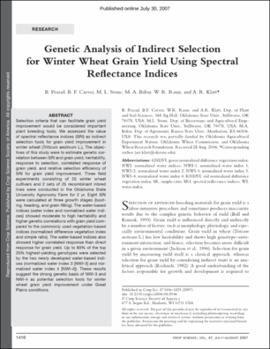| dc.contributor.author | Prasad, B. | |
| dc.contributor.author | Carver, B. F. | |
| dc.contributor.author | Stone, M. L. | |
| dc.contributor.author | Babar, M. A. | |
| dc.contributor.author | Raun, W. R. | |
| dc.contributor.author | Klatt, A. R. | |
| dc.date.accessioned | 2015-10-16T20:47:52Z | |
| dc.date.available | 2015-10-16T20:47:52Z | |
| dc.date.issued | 2007-07-30 | |
| dc.identifier | okds_Carver_CS_2007-07-30_2.pdf | |
| dc.identifier.citation | Prasad, B., Carver, B. F., Stone, M. L., Babar, M. A., Raun, W. R., & Klatt, A. R. (2007). Genetic analysis of indirect selection for winter wheat grain yield using spectral reflectance indices. Crop Science, 47(4), 1416-1425. https://doi.org/10.2135/cropsci2006.08.0546 | |
| dc.identifier.uri | https://hdl.handle.net/11244/19806 | |
| dc.description.abstract | Selection criteria that can facilitate grain yield improvement would be considered important plant breeding tools. We assessed the value of spectral reflectance indices (SRI) as indirect selection tools for grain yield improvement in winter wheat (Triticum aestivum L.). The objectives of this study were to estimate genetic correlation between SRI and grain yield, heritability, response to selection, correlated response of grain yield, and relative selection efficiency of SRI for grain yield improvement. Three field experiments consisting of 25 winter wheat cultivars and 2 sets of 25 recombinant inbred lines were conducted in the Oklahoma State University Agronomy Farm for 2 yr. Eight SRI were calculated at three growth stages (booting, heading, and grain-filling). The water-based indices (water index and normalized water indices) showed moderate to high heritability and higher genetic correlations with grain yield compared to the commonly used vegetation-based indices (normalized difference vegetation index and simple ratio). The water-based indices also showed higher correlated response than direct response for grain yield. Up to 83% of the top 25% highest-yielding genotypes were selected by the two newly developed water-based indices (normalized water index 3 [NWI-3] and normalized water index 4 [NWI-4]). These results suggest the strong genetic basis of NWI-3 and NWI-4 as potential selection tools for winter wheat grain yield improvement under Great Plains conditions. | |
| dc.format | application/pdf | |
| dc.language | en_US | |
| dc.publisher | Crop Science Society of America | |
| dc.rights | This material has been previously published. In the Oklahoma State University Library's institutional repository this version is made available through the open access principles and the terms of agreement/consent between the author(s) and the publisher. The permission policy on the use, reproduction or distribution of the material falls under fair use for educational, scholarship, and research purposes. Contact Digital Resources and Discovery Services at lib-dls@okstate.edu or 405-744-9161 for further information. | |
| dc.title | Genetic analysis of indirect selection for winter wheat grain yield using spectral reflectance indices | |
| osu.filename | okds_Carver_CS_2007-07-30_2.pdf | |
| dc.description.peerreview | Peer reviewed | |
| dc.identifier.doi | 10.2135/cropsci2006.08.0546 | |
| dc.description.department | Plant and Soil Sciences | |
| dc.description.department | Biosystems and Agricultural Engineering | |
| dc.type.genre | Article | |
| dc.type.material | Text | |
